

Barjou
Guide des espèces. Etudes sur les peches et l'environnement dans le bassin de la Mer Noire. 03680770.1948. La culture intensive d’une algue risque de conduire à son extinction. Transport de l’algue rouge Gracilaria gracilis après récolte dans la région de Chiloe, sud du Chili.
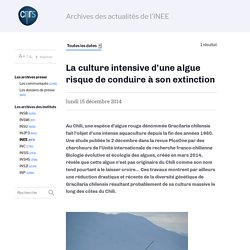
. © Marie-Laure Guillemin, Université Australe du Chili, Valdivia En l’espace de plusieurs milliers d’années, l’Homme n’a cessé de domestiquer les animaux et les plantes qui l’entourent. Il en va de même pour Gracilaria chilensis, une espèce d’algue rouge présente le long des côtes chiliennes. Rapport WP1 FR 1. Ces algues qui nous entourent: conception actuelle, rôle dans la biosphère ... - René Pérez. Ch09. Le dragageLutte antipollution Un abri de pêche nécessite généralement un entretien régulier pour pouvoir remplir convenablement sa fonction.

ÉTAPES DE PRODUCTION D'ALGUES DE CULTURE. Couplage metha spiruline ademe. Captage et stockage du CO2: Enjeux techniques et sociaux en France - Minh Ha-Duong, Naceur Chaabane. Algocultures. A BO100f. Redirecting. JavaScript is disabled on your browser.

Please enable JavaScript to use all the features on this page. Abstract A 2 × 2 factorial experiment was conducted to investigate the interactions between two different lactose (L) levels (150 g/kg vs. 250 g/kg) and seaweed extract (SWE): (0 g/kg vs. 2.8 g/kg; containing laminarin and fucoidan) derived from Laminaria spp. on growth performance, coefficient of total tract apparent digestibility (CTTAD) and faecal microbial populations in the weanling pig. Two hundred and forty pigs (120 male and 120 female) were selected after weaning (24 days of age, 7.6 ± 0.9 kg live weight) and blocked on the basis of live weight and within each block assigned to one of the four dietary treatments. Redirecting. Alltech – 2014 Global Feed Survey Summary – Animal Feed Market. In the last days I had a look in to Alltech survey 2014 comparing with the same informations from 2013 report.
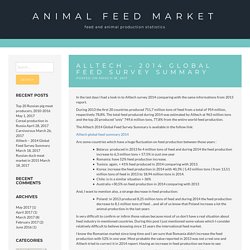
During 2013 the first 20 countries produced 751,7 million tons of feed from a total of 954 million, respectively 78,8%. The total feed produced during 2014 was estimated by Alltech at 963 million tons and the top 20 produced “only” 749,6 million tons, 77,8% from the entire world feed production. The Alltech 2014 Global Feed Survey Summary is available in the follow link: N-3 Fatty acid co nte nt i n eggs laid by he ns fed with mari ne algae a nd sardi ne oil a nd stored at differe nt times a nd temperatures.
Safety of Novel Protein Sources (Insects, Microalgae, Seaweed, Duckweed, and Rapeseed) and Legislative Aspects for Their Application in Food and Feed Production - Spiegel - 2013 - Comprehensive Reviews in Food Science and Food Safety. Introduction In response to the Kyoto Protocol on the global climate, the European Union (EU) made agreements on reducing greenhouse gas emissions.
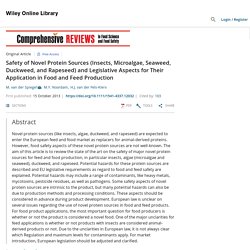
Major sources of these gas emissions are cattle breeding and related meat consumption (Steinfeld and others 2006; Van Beukering and others 2008). In the last decades, the global consumption of animal proteins has increased continuously. Between 1950 and 2000, the global human population more than doubled from 2.7 to 6 billion people. Meat production, however, increased by a factor of 5 from 45 to 233 billion kg per year. Bioactive compounds in seaweed: functional food applications and legislation. Redirecting. JavaScript is disabled on your browser.
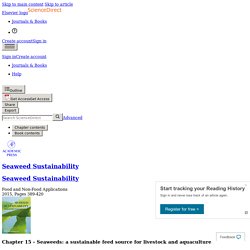
Please enable JavaScript to use all the features on this page. Abstract Utilization of seaweed as a feed supplement for animals is not a new phenomenon; in fact, it has been utilized by farmers as a valuable feed source for livestock and aquaculture for ages. This chapter addresses the worth of seaweed as a sustainable feed ingredient in diets of farm and aquatic animals. Marine Medicinal Foods: Implications and Applications, Macro and Microalgae.
Nutritional Value of Seaweeds by Patricia Burtin. Effect of premix and seaweed additives on productive performance of lactating friesian cows. Abstract Bendary, M.M, M.I.
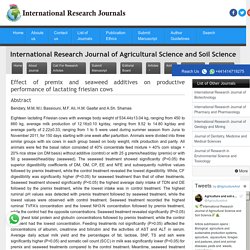
Bassiouni, M.F. Ali, H.M. Gaafar and A.Sh. Shamas. Teaching an Environmental Chemistry Experiment—A Case Study. Seaweed proteins: biochemical, nutritional aspects and potential uses. Nutritional and Digestive Health Benefits of Seaweed. JavaScript is disabled on your browser.
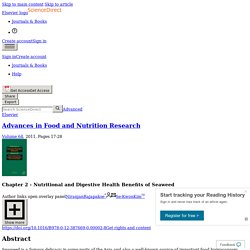
Please enable JavaScript to use all the features on this page. Abstract Seaweed is a famous delicacy in some parts of the Asia and also a well-known source of important food hydrocolloids, such as agar, alginates, and carrageenan. In addition to the food value of seaweed, several health benefits have also been reported to be present in this valuable food source. It is presumed that the unique features of the marine environment, where the seaweeds are grown, are mainly responsible for most of its properties. Keywords. Wp-signup.php?new=www.ceva. L'algoculture dans le monde et ses contraintes. L'importance économique des aquacultures s'est accrue au cours de la décennie 1970.
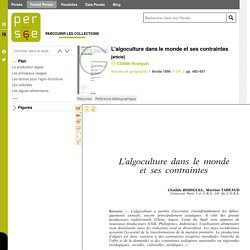
Parmi ces activités halieutiques, la culture d'algues est certainement moins répandue en France qu'en Asie, où elle a un poids économique considérable par la main d'œuvre qu'elle emploie comme par les industries qu'elle induit. Faute de données globales très anciennes, il est difficile de chiffrer l'évolution de la production. Dans l'ensemble, un long palier ou une croissance très faible caractérise la période de cueillette.
Celle-ci, dans certaines sociétés asiatiques, remonte à l'antiquité et régresse depuis le milieu de ce siècle. 10 % seulement de la production viennent de récoltes sur champs naturels, mais ils ne sont pas négligeables économiquement. Parallèlement, un changement technologique fondamental a permis depuis une vingtaine d'années d'accroître la production par algoculture, dans des proportions que la biomasse naturelle n'autorisait pas. Chiffres cles 2015 vf. Accueil. CELEX%3A32002L0046%3AFR%3ATXT. 32012R0432. Listing the World's Algae. Ces algues qui nous entourent: conception actuelle, rôle dans la biosphère ... - René Pérez. 1530088446.